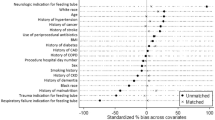Abstract
Background
Gastrostomy tube insertion is beneficial to selected patients, and percutaneous endoscopic gastrostomy (PEG) and percutaneous radiological gastrostomy (PRG) are two of the frequently used methods in gastrostomy. This study aimed to investigate the indications and complications of both PEG and PRG.
Methods
This was a retrospective multicenter cohort study. Patients who underwent initial PEG or PRG tube insertion for nutritional purpose between January 2010 and December 2015 at five university hospitals were included in the study. We analyzed the indications and all complications related to gastrostomy, which were divided into the major (systemic or life-threatening) and minor (local and non-life-threatening) categories.
Results
A total of 418 patients who underwent PEG (n = 324) and PRG (n = 94) were reviewed. The indications for gastrostomy tube insertion were different and included mainly neurological disease (n = 240, 74.1%) such as cerebrovascular accident in the PEG group (n = 119, 36.7%) and mainly surgical disease (n = 28, 29.8%) such as head and neck cancer (n = 16, 17.0%) in the PRG group (p = 0.05). There were no differences in the minor (16.4% vs. 19.1%, p = 0.52) and major (12.3% vs. 14.9%, p = 0.51) complication rates between the PEG and PRG groups. The risk factors for complications were age [yearly increments; odds ratio (OR) 1.03, 95% confidence interval (CI) 1.01–1.06], tube diameter (1-Fr increments; OR 1.26, 95% CI 1.01–1.58), insertion time (1-min increments; OR 1.07, 95% CI 1.01–1.13), and neurological disease as the gastrostomy indication (vs. surgical disease; OR 4.61 95% CI 1.47–14.42).
Conclusions
In our study, both PEG and PRG provided a safe route for nutrition delivery despite their different indications. Our data suggest that PEG might be the procedure of choice for patients with medical or neurological disease and PRG for patients with surgical disease in whom PEG is technically difficult or contraindicated.
Similar content being viewed by others
References
Lee SP, Lee KN, Lee OY, Lee HL, Jun DW, Yoon BC, Choi HS, Kim SH (2014) Risk factors for complications of percutaneous endoscopic gastrostomy. Dig Dis Sci 59:117–125
MacLean AA, Alvarez NR, Davies JD, Lopez PP, Pizano LR (2007) Complications of percutaneous endoscopic and fluoroscopic gastrostomy tube insertion procedures in 378 patients. Gastroenterol Nurs 30:337–341
Gramlich L, Kichian K, Pinilla J, Rodych NJ, Dhaliwal R, Heyland DK (2004) Does enteral nutrition compared to parenteral nutrition result in better outcomes in critically ill adult patients? A systematic review of the literature. Nutrition 20:843–848
Moller P, Lindberg CG, Zilling T (1999) Gastrostomy by various techniques: evaluation of indications, outcome, and complications. Scand J Gastroenterol 34:1050–1054
Wollman B, D’Agostino HB (1997) Percutaneous radiologic and endoscopic gastrostomy: a 3-year institutional analysis of procedure performance. AJR Am J Roentgenol 169:1551–1553
Thornton FJ, Varghese JC, Haslam PJ, McGrath FP, Keeling F, Lee MJ (2000) Percutaneous gastrostomy in patients who fail or are unsuitable for endoscopic gastrostomy. Cardiovasc Intervent Radiol 23:279–284
ProGas Study Group (2015) Gastrostomy in patients with amyotrophic lateral sclerosis (ProGas): a prospective cohort study. Lancet Neurol 14:702–709
Blondet A, Lebigot J, Nicolas G, Boursier J, Person B, Laccoureye L, Aube C (2010) Radiologic versus endoscopic placement of percutaneous gastrostomy in amyotrophic lateral sclerosis: multivariate analysis of tolerance, efficacy, and survival. J Vasc Interv Radiol 21:527–533
Allen JA, Chen R, Ajroud-Driss S, Sufit RL, Heller S, Siddique T, Wolfe L (2013) Gastrostomy tube placement by endoscopy versus radiologic methods in patients with ALS: a retrospective study of complications and outcome. Amyotroph Lateral Scler Frontotemporal Degener 14:308–314
Rustom IK, Jebreel A, Tayyab M, England RJ, Stafford ND (2006) Percutaneous endoscopic, radiological and surgical gastrostomy tubes: a comparison study in head and neck cancer patients. J Laryngol Otol 120:463–466
Neeff M, Crowder VL, McIvor NP, Chaplin JM, Morton RP (2003) Comparison of the use of endoscopic and radiologic gastrostomy in a single head and neck cancer unit. ANZ J Surg 73:590–593
Eze N, Jefford JM, Wolf D, Williamson P, Neild P (2007) PEG and RIG tube feeding in Head and Neck patients: a retrospective review of complications and outcome. J Eval Clin Pract 13:817–819
Silas AM, Pearce LF, Lestina LS, Grove MR, Tosteson A, Manganiello WD, Bettmann MA, Gordon SR (2005) Percutaneous radiologic gastrostomy versus percutaneous endoscopic gastrostomy: a comparison of indications, complications and outcomes in 370 patients. Eur J Radiol 56:84–90
Santos PM, McDonald J (1999) Percutaneous endoscopic gastrostomy: avoiding complications. Otolaryngol Head Neck Surg 120:195–199
Preclik G, Grune S, Leser HG, Lebherz J, Heldwein W, Machka K, Holstege A, Kern WV (1999) Prospective, randomised, double blind trial of prophylaxis with single dose of co-amoxiclav before percutaneous endoscopic gastrostomy. BMJ 319:881–884
Gossner L, Keymling J, Hahn EG, Ell C (1999) Antibiotic prophylaxis in percutaneous endoscopic gastrostomy (PEG): a prospective randomized clinical trial. Endoscopy 31:119–124
Sturgis TM, Yancy W, Cole JC, Proctor DD, Minhas BS, Marcuard SP (1996) Antibiotic prophylaxis in percutaneous endoscopic gastrostomy. Am J Gastroenterol 91:2301–2304
Thornton FJ, Fotheringham T, Haslam PJ, McGrath FP, Keeling F, Lee MJ (2002) Percutaneous radiologic gastrostomy with and without T-fastener gastropexy: a randomized comparison study. Cardiovasc Intervent Radiol 25:467–471
Galaski A, Peng WW, Ellis M, Darling P, Common A, Tucker E (2009) Gastrostomy tube placement by radiological versus endoscopic methods in an acute care setting: a retrospective review of frequency, indications, complications and outcomes. Can J Gastroenterol 23:109–114
Author information
Authors and Affiliations
Consortia
Corresponding author
Ethics declarations
Disclosure
Soo-Kyung Park, Ji Yeon Kim, Seong-Joon Koh, Yoo Jin Lee, Hyun Joo Jang, and Soo Jung Park have no conflicts of interest or financial ties to disclose.
Rights and permissions
About this article
Cite this article
Park, SK., Kim, J.Y., Koh, SJ. et al. Complications of percutaneous endoscopic and radiologic gastrostomy tube insertion: a KASID (Korean Association for the Study of Intestinal Diseases) study. Surg Endosc 33, 750–756 (2019). https://doi.org/10.1007/s00464-018-6339-1
Received:
Accepted:
Published:
Issue Date:
DOI: https://doi.org/10.1007/s00464-018-6339-1




